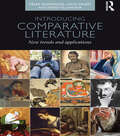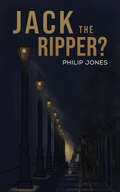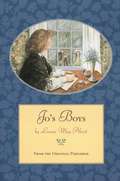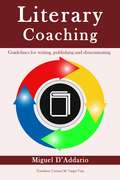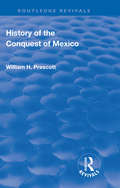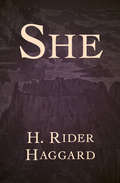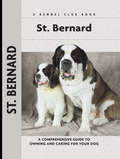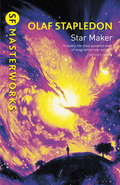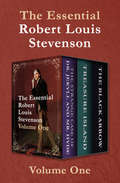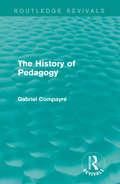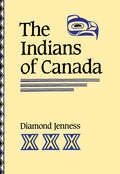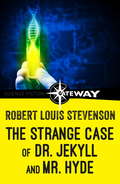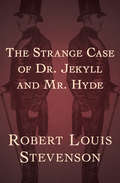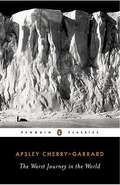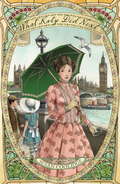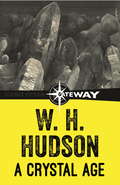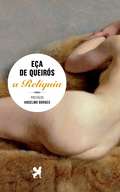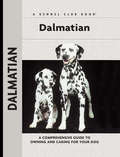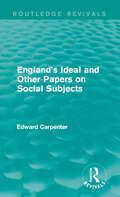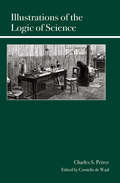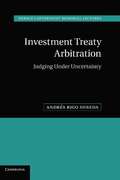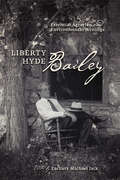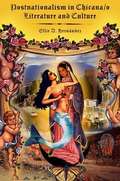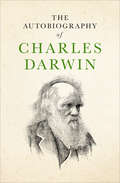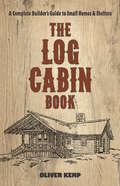- Table View
- List View
Introducing Comparative Literature: New Trends and Applications
by Haun Saussy César Domínguez Darío VillanuevaIntroducing Comparative Literature is a comprehensive guide to the field offering clear, concise information alongside useful analysis and examples. It frames the introduction within recent theoretical debates and shifts in the discipline whilst also addressing the history of the field and its practical application. Looking at Comparative Literature within the context of globalization, cosmopolitanism and post or transnationalism, the book also offers engagement and comparison with other visual media such as cinema and e-literature. The first four chapters address the broad theoretical issues within the field such as 'interliterary theory', decoloniality, and world literature, while the next four are more applied, looking at themes, translation, literary history and comparison with other arts. This engaging guide also contains a glossary of terms and concepts as well as a detailed guide to further reading.
Jack the Ripper?
by Philip JonesReaders are transported to Victorian London and introduced to Inspector Doyle, a modern-day detective with eternal life, who discovers that he has been wrongly named as ‘Jack the Ripper’, the Victorian serial killer. Nobody wants that label at any time in history, so with the aid of time travel he returns to the year 1888 in an attempt to clear his name. Another complication for Inspector Doyle is that his modern-day daughter, Flora, who he has left behind to travel back several centuries, is becoming increasingly suspicious of her father’s identity. This is after making her way into his Shrewsbury study, that she is forbidden to enter. The only good thing about returning to 1888 is that Inspector Doyle is able to rekindle his relationship with daughter Alice and wife Eleanor, who he had to leave behind all those centuries ago. Alice can then only but marvel at her father’s abilities to answer a question that only he knows the answer to, because he has travelled into the future and back. The story references many Victorian objects that have been meticulously researched and then used to tell a story that is only possible through time travel and a rather clever inventor who may or may not be still alive. Many elements of the original Jack the Ripper case are also detailed as are the horrors of Whitechapel. Find out whether Inspector Doyle manages to clear his name by discovering who the real Jack the Ripper is, and expect a twist at the end that involves both daughters and a Victorian book that, unlike the rest of Inspector Doyle’s objects, is unable to exist in parallel between the two time zones.
Jo's Boys: How They Turned Out
by Louisa May AlcottThis sequel to Alcott's "Little Women" and "Little Men" chronicles the return of the classmates of Plumfield, Jo's school for boys. Readers re-encounter Nat, the orphaned street musician, now a conservatory student; restless Dan, back from the gold mines of California; business-minded Tom; and other old friends.
Literary Coaching - Guidelines for writing, publishing and disseminating
by Miguel D'AddarioWriting is a vocation, born of a need of each person. It is an inner manifestation, a communicational expression, be it artistic, scientific or of another literary genre. It is a property of the human being, communication through writing. This means that each one will do it in their own way and form, in the same way that each reader will interpret the content of a book, magazine or other, in a different way, understanding according to their own abilities and knowledge. San Buenaventura de Bagnoregio, wrote in the thirteenth century, that there were four ways to make a book: 1. Being a Scribe (Scriptor): Someone who writes the works of others without adding, changing or removing anything from the original text. 2. Being a Compiler (Compilator): Someone who writes works of others with additions that are not his (also others). 3. Being a Commentator (Comentator): Someone who writes the works of others and their own, giving them the primary place to the works of others with clarifying aggregates. 4. Being an Author (Auctor): Someone who writes his own works and others, but giving the primary place to his writings and adding others to assert his own text. Therefore, a person who writes is, in short, an Author, regardless of whether he has published his work or not. And the difference lies in the legal nature that the company manages by identifying each work, the ISBN. This number makes up the legal nature of a publication, and inserts this work in the international bibliographic bases, it is the identity document of each book.
Revival: With a Preliminary View of the Ancient Mexican Civilisation and the Life of the Conqueror, Hernando Cortes (Routledge Revivals)
by William H PrescottA dramatic account of the conquest of Mexico, from first contact with the Aztec civilisation through to Cortes' expulsion and subsequent career. The book is not only interesting for the historic content withe relevance to Latin America to this day, but also as a notable example of historical scholarship and of English literature in general.
She: Large Print (Ayesha)
by H. Rider HaggardH. Rider Haggard&’s classic tale of fantasy and adventure set in a lost world ruled by a two-thousand-year-old queen On the occasion of his twenty-fifth birthday, Leo Vincey opens the locked iron box that is his birthright and finds an ancient potsherd. Following clues engraved on the relic, Vincey and the man who raised him, Cambridge professor Horace Holly, embark on a remarkable adventure that will take them from Victorian England to an uncharted region in East Africa. Surviving shipwreck, disease, and hostile natives, they discover a lost civilization no European has ever encountered—or lived to describe. They have entered the realm of the cruel and beautiful Ayesha, known to those who worship her as &“She-who-must-be-obeyed.&” For two thousand years, the white queen has been waiting—for what, Vincey and Holly are about to find out. One of the bestselling novels of all time, She has held readers in its thrall for more than a century. Alongside Haggard&’s other classic, King Solomon&’s Mines, it established the conventions of the lost world fantasy genre, and has inspired some of our greatest thinkers and writers, from Sigmund Freud to J. R. R. Tolkien to Margaret Atwood. This ebook has been professionally proofread to ensure accuracy and readability on all devices.
St. Bernard
by J. Radford WilcockThe experts at Kennel Club Books present the world's largest series of breed-specific canine care books. Each critically acclaimed Comprehensive Owner's Guide covers everything from breed standards to behavior, from training to health and nutrition. With nearly 200 titles in print, this series is sure to please the fancier of even the rarest breed!
Star Maker
by Olaf StapledonOne moment a man sits on a suburban hill, gazing curiously at the stars. The next, he is whirling through the firmament, and perhaps the most remarkable of all science fiction journeys has begun. Even Stapledon's other great work, LAST AND FIRST MEN, pales in ambition next to STAR MAKER, which presents nothing less than an entire imagined history of life in the universe, encompassing billions of years.
The Essential Robert Louis Stevenson Volume One: The Strange Case of Dr. Jekyll and Mr. Hyde, Treasure Island, and The Black Arrow
by Robert Louis StevensonThree beloved nineteenth-century classics featuring pirate adventures, sparring knights, and gothic chills.The Strange Case of Dr. Jekyll and Mr. Hyde: In this timeless gothic horror novella, the upstanding Dr. Jekyll is plagued by his association with the mysterious and murderous brute Mr. Hyde—until the shocking truth of the doctor&’s dual nature is revealed.Treasure Island: This classic adventure novel tells the story of young Jim Hawkins, who finds a treasure map and gets wrapped up in the devious plots of the notorious pirate Long John Silver.The Black Arrow: This romantic adventure novel, set in fifteenth-century England, follows the chivalrous Dick Shelton as he avenges his father&’s murder and saves his love, Joanna, with the help of a band of outlaws known as the Black Arrow.
The History of Pedagogy (Routledge Revivals)
by Gabriel CompayréPayne’s translation of Compayré’s The History of Pedagogy was initially published in 1886 due to a general lack of historical texts on education in the late nineteenth century. Compayré provides a thorough account of the doctrines and methods used by educators throughout history from educators of antiquity to the early nineteenth century. This text focusses on key thinkers and teachers such as Locke, Luther and Kant as well as considering the educational methods of the Greeks and the Romans. This title will be of interest to students of Education and Philosophy.
The Indians of Canada
by Diamond JennessFirst published in 1932, The Indians of Canada remains the most comprehensive works available on Canada's Indians. Part one includes chapters on languages, economic conditions, food resources, hunting and fishing, dress and adornment, dwellings, travel and transportation, trade and commerce, social and political organization, social life, religion, folklore and traditions, and drama, music, and art. The second part of the book describes the tribes in different groupings: the migratory tribbes of the eastern woodlands, the plains tribes, tribes of the Pacific coast, of the Cordillera, and the Mackenzie and Yukon River basins, and finally the Eskimo.
The Strange Case of Dr Jekyll and Mr Hyde: No More Mr Nice Guy... (Pulp! The Classics Ser.)
by Robert Louis Stevenson Bryan Hitch'He put the glass to his lips, and drank at one gulp. A cry followed; he reeled, staggered, clutched at the table and held on, staring with injected eyes, gasping with open mouth; and as I looked there came, I thought, a change-he seemed to swell-his face became suddenly black and the features seemed to melt and alter...'Troubled by the strange behaviour of his friend, Dr Jekyll, a young London lawyer decides to investigate. But the truth, as he discovers that Jekyll and the brutal Edward Hyde are one and the same is more terrible than he could possibly have anticipated...
The Strange Case of Dr. Jekyll and Mr. Hyde: New Release 2019, The Strange Case Of Dr Jekyll And Mr Hyde By Robert Louis Stevenson, A Classic Novel With Blank Notes As A Study Guide, Evergreen (Pulp! The Classics Ser.)
by Robert Louis StevensonThe most infamous of horror stories—a disturbing examination of man&’s capacity for evilOne pitch-black London morning, a ghoulish little man tramples a young girl and continues heedlessly on his way. Caught by a passerby and returned to the scene of the crime, the man is forced to pay £100 in restitution. He produces ten pounds in gold and a check for the remainder. Curiously, the check bears the signature of the well-regarded Dr. Henry Jekyll. Even stranger, Dr. Jekyll&’s will names this same awful and mysterious little man, Mr. Hyde, as the sole beneficiary. Troubled by the coincidence, Dr. Jekyll&’s attorney visits his client. What he uncovers is a tale so strange and terrifying it has seeped into the very fabric of our consciousness.An immediate success upon its publication in 1886 and a cultural touchstone to this day, The Strange Case of Dr. Jekyll and Mr. Hyde is one of the most disturbing stories ever told. This ebook has been professionally proofread to ensure accuracy and readability on all devices.
The Worst Journey in the World (Barnes And Noble Library Of Essential Reading Ser.)
by Caroline Alexander Apsley Cherry-GarrardA firsthand account of Scott's disastrous Antarctic expeditionThe Worst Journey in the World recounts Robert Falcon Scott's ill-fated expedition to the South Pole. Apsley Cherry-Garrard--the youngest member of Scott's team and one of three men to make and survive the notorious Winter Journey--draws on his firsthand experiences as well as the diaries of his compatriots to create a stirring and detailed account of Scott's legendary expedition. Cherry himself would be among the search party that discovered the corpses of Scott and his men, who had long since perished from starvation and brutal cold. It is through Cherry's insightful narrative and keen descriptions that Scott and the other members of the expedition are fully memorialized.For more than seventy years, Penguin has been the leading publisher of classic literature in the English-speaking world. With more than 1,700 titles, Penguin Classics represents a global bookshelf of the best works throughout history and across genres and disciplines. Readers trust the series to provide authoritative texts enhanced by introductions and notes by distinguished scholars and contemporary authors, as well as up-to-date translations by award-winning translators.From the Trade Paperback edition.
What Katy Did Next: Large Print (What Katy Did #3)
by Susan Coolidge'Katy speaks with a charm and directness that remains as fresh as when it was written' Amanda CraigEurope beckoned more brilliantly now that they were fairly embarked on their journey. The sun shone, the lake was a beautiful, dazzling blue, and Katy said to herself, "After all, a year is not very long, and how happy I am going to be!"'When Mrs Ashe discovers that her visiting nephew has scarlet fever, she sends her young daughter Amy to stay with the Carr family. There, Amy develops a strong attachment to Katy, who treats her like a little sister. Mrs Ashe, grateful for the kindness Katy has shown, invites her to join them on a year-long trip around Europe. Katy is at first reluctant - a year is a long time to be away from her family - but soon she gets swept up in the adventure, which takes her from the historic (but rainy) London streets to the beautiful cities of Nice, Paris and Naples. And perhaps Katy, now a young woman, will discover love.A collection that will be coveted by children and adults alike, this list is the best in children's literature, curated by Virago. These are timeless tales with beautiful covers, that will be treasured and shared across the generations. Some titles you will already know; some will be new to you, but there are stories for everyone to love, whatever your age. Our list includes Nina Bawden (Carrie's War, The Peppermint Pig), Rumer Godden (The Dark Horse, An Episode of Sparrows), Joan Aiken (The Serial Garden, The Gift Giving) E. Nesbit (The Psammead Trilogy, The Bastable Trilogy, The Railway Children), L. M. Montgomery (The Anne of Green Gables series) and Susan Coolidge (The What Katy Did Trilogy). Discover Virago Children's Classics.
A Crystal Age
by Bryan Hitch W. H HudsonA Crystal Age is one of the earliest science-fiction novels which deals with a utopia of the distant future. The first-person narrator, a traveler and naturalist, wakes to find himself buried in earth and vegetation. He comes across a community of people who live in a mansion together, under a foreign set of rules and cultural assumptions. He falls desperately in love with a girl from the community, but the very basis of their utopia forbids his ever consummating his desires.
A Relíquia
by Eça De Queirós Emanuel Bento Anselmo BorgesA Relíquia foi escrita em 1887. Mas, em 2010, mergulhados numa profundíssima crise da Igreja e da sociedade, não é consumidos pelas "incertezas da Inteligência" e angustiados pelos "tormentos do Dinheiro" que continuamos? Quando do que mais se precisa é do confronto com "a nudez forte da verdade" e com "uma lição lúcida e forte (...)".
Dalmatian
by Frances CampJudged and recognized by his spots, the Dalmatian is unmistakable among purebred dogs, a versatile, intelligent breed distinguished by his perfectly spotted coat (black or liver on a solid white background). From coach dog and firehouse mascot to Hollywood star and stunt dog, the Dalmatian enjoys being the center of attention and seems to be able to do it all. This Comprehensive Owner's Guide presents a realistic portrayal of this demanding purebred dog, whose energy and training demands are far beyond the scope and ability of most first-time owners. Due to the popularity of the famous Disney films, Dalmatians have long been the most likely "impulse buy" in the dog world, which has led to many Dalmatians being abandoned in shelters. The author, Frances Camp does well to give the reader perspective on the handsome, but high-energy companion dog that develops from the squirmy puppy on the silver screen. The first chapter on the history of the Dalmatian discusses the breed's evolution, the origins of the spotted coat, and how it became so popular in Europe and America.New owners will welcome the well-prepared chapter on finding a reputable breeder and selecting a healthy, sound puppy. Chapters on puppy-proofing the home and yard, purchasing the right supplies for the puppy as well as house-training, feeding, and grooming are illustrated with photographs of handsome adults and puppies. In all, there are over 135 full-color photographs in this useful and reliable volume. The author's advice on obedience training will help the reader better mold and train into the most well-mannered dog in the neighborhood. The extensive and lavishly illustrated chapter on healthcare provides up-to-date detailed information on selecting a qualified veterinarian, vaccinations, preventing and dealing with parasites, infectious diseases, and more. Sidebars throughout the text offer helpful hints, covering topics as diverse as historical dogs, breeders, or kennels, toxic plants, first aid, crate training, carsickness, fussy eaters, and parasite control. Fully indexed.
England's Ideal and Other Papers on Social Subjects: And Other Papers On Social Subjects (1895) (Routledge Revivals: The Collected Works of Edward Carpenter)
by Edward CarpenterOriginally published in 1887, Edward Carpenter’s England’s Ideal and other Papers on Social Subjects is a collection of his essays in the field of Social Science with a focus on English society at the time of writing. His writing was so influential that there was a near constant demand in the late nineteenth and early twentieth centuries for this work to be reprinted with this particular edition being published in 1919. Papers included in this volume discuss issues such as labour, trade and property and all provide insight into the English class structure as well as illuminating Carpenter’s socialist values. This title will be of interest to students of sociology.
Illustrations of the Logic of Science
by Cornelis De Waal Charles Sanders PeirceCharles Peirce's Illustrations of the Logic of Science is an early work in the philosophy of science and the official birthplace of pragmatism. It contains Peirce's two most influential papers: "The Fixation of Belief" and "How to Make Our Ideas Clear," as well as discussions on the theory of probability, the ground of induction, the relation between science and religion, and the logic of abduction. Unsatisfied with the result and driven by a constant, almost feverish urge to improve his work, Peirce spent considerable time and effort revising these papers. After the turn of the century these efforts gained significant momentum when Peirce sought to establish his role in the development of pragmatism while distancing himself from the more popular versions that had become current. The present edition brings together the original series as it appeared in Popular Science Monthly and a selection of Peirce's later revisions, many of which remained hidden in the mass of messy manuscripts that were left behind after his death in 1914.
Investment Treaty Arbitration
by Andrés Rigo SuredaInvestment claims have exposed the vague nature of the standards by which arbitral tribunals are expected to adjudicate them and the policy reasons which explicitly or implicitly have an influence. The ad hoc nature of the tribunals and the decisions reached on various controversial issues have brought to the fore the issue of consistency. Andrés Rigo Sureda's Hersch Lauterpacht Memorial Lecture examines how arbitral discretion is exercised in the face of uncertainty of the law. It explores the choices made by arbitral tribunals as they approach treaty interpretation, as they search for limits in determining jurisdiction and the content of the standards of protection and as they search for consistency in the exercise of arbitral discretion.
Liberty Hyde Bailey: Essential Agrarian and Environmental Writings
by Liberty Hyde Bailey"Nature-study not only educates, but it educates nature-ward; and nature is ever our companion, whether we will or no. Even though we are determined to shut ourselves in an office, nature sends her messengers. The light, the dark, the moon, the cloud, the rain, the wind, the falling leaf, the fly, the bouquet, the bird, the cockroach-they are all ours. If one is to be happy, he must be in sympathy with common things. He must live in harmony with his environment. One cannot be happy yonder nor tomorrow: he is happy here and now, or never. Our stock of knowledge of common things should be great. Few of us can travel. We must know the things at home."—from "The Meaning of the Nature-study Movement""To feel that one is a useful and cooperating part in nature is to give one kinship, and to open the mind to the great resources and the high enthusiasms. Here arise the fundamental common relations. Here arise also the great emotions and conceptions of sublimity and grandeur, of majesty and awe, the uplift of vast desires—when one contemplates the earth and the universe and desires to take them into the soul and to express oneself in their terms; and here also the responsible practices of life take root."—from The Holy EarthBefore Wendell Berry and Aldo Leopold, there was the horticulturalist and botanist Liberty Hyde Bailey (1858–1954). For Wendell Berry, Bailey was a revelation, a symbol of the nature-minded agrarianism Berry himself popularized. For Aldo Leopold, Bailey offered a model of the scholar-essayist-naturalist. In his revolutionary work of eco-theology, The Holy Earth, Bailey challenged the anthropomorphism—the people-centeredness—of a vulnerable world. A trained scientist writing in the lyrical tradition of Emerson, Burroughs, and Muir, Bailey offered the twentieth century its first exquisitely interdisciplinary biocentric worldview; this Michigan farmer's son defined the intellectual and spiritual foundations of what would become the environmental movement.For nearly a half century, Bailey dominated matters agricultural, environmental, and scientific in the United States. He worked both to improve the lives of rural folk and to preserve the land from which they earned their livelihood. Along the way, he popularized nature study in U.S. classrooms, lobbied successfully for women's rights on and off the farm, and bulwarked Teddy Roosevelt's pioneering conservationism.Here for the first time is an anthology of Bailey's most important writings suitable for the general and scholarly reader alike. Carefully selected and annotated by Zachary Michael Jack, this book offers a comprehensive introduction to Bailey's celebrated and revolutionary thinking on the urgent environmental, agrarian, educational, and ecospiritual dilemmas of his day and our own. Culled from ten of Bailey's most influential works, these lyrical selections highlight Bailey's contributions to the nature-study and the Country Life movements. Published on the one-hundredth anniversary of Bailey's groundbreaking report on behalf of the Country Life Commission, Liberty Hyde Bailey: Essential Agrarian and Environmental Writings will inspire a new generation of nature writers, environmentalists, and those who share with Bailey a profound understanding of the elegance and power of the natural world and humanity's place within it.
Postnationalism in Chicana/o Literature and Culture
by Ellie D. HernándezIn recent decades, Chicana/o literary and cultural productions have dramatically shifted from a nationalist movement that emphasized unity to one that openly celebrates diverse experiences. Charting this transformation, Postnationalism in Chicana/o Literature and Culture looks to the late 1970s, during a resurgence of global culture, as a crucial turning point whose reverberations in twenty-first-century late capitalism have been profound.<P><P>Arguing for a postnationalism that documents the radical politics and aesthetic processes of the past while embracing contemporary cultural and sociopolitical expressions among Chicana/o peoples, Hernández links the multiple forces at play in these interactions. Reconfiguring text-based analysis, she looks at the comparative development of movements within women's rights and LGBTQI activist circles. Incorporating economic influences, this unique trajectory leads to a new conception of border studies as well, rethinking the effects of a restructured masculinity as a symbol of national cultural transformation. Ultimately positing that globalization has enhanced the emergence of new Chicana/o identities, Hernández cultivates important new understandings of borderlands identities and postnationalism itself.
The Autobiography of Charles Darwin: Super Large Print Edition Of The Classic Memoir For Low Vision Readers (Barnes And Noble Library Of Essential Reading Series)
by Charles DarwinThis edition of Darwin&’s life story restores previously censored passages on religion and the scientist&’s opinions of his contemporaries. Darwin wrote his autobiography in 1876, at the age of sixty-seven, hoping it would prove interesting to his children and grandchildren. Preparing the book for a wider audience, his family initially sought to protect his legacy by removing passages they found too personal or controversial. This restored edition, which appeared one hundred years after the publication of On the Origin of Species, was edited by Darwin&’s own granddaughter Nora Barlow, who wished to share the text as it originally existed in her family&’s archives. Shedding light on the women in Darwin&’s life and his evolving views on religion, The Autobiography of Charles Darwin delves deep into his brilliant yet shy and reclusive personality, from his childhood love of nature to the reception of his groundbreaking theories on evolution. It also includes previously unpublished notes and letters on family matters, as well as Darwin&’s dispute with Samuel Butler.
The The Log Cabin Book: A Complete Builder's Guide to Small Homes and Shelters
by Oliver KempThis vintage guide from over a century ago offers timeless, practical advice on building log cabins. Plans and directions for simple structures are easy enough for amateurs to follow; time and inclination are the only necessary elements. Each of the designs has been tested and allows numberless alterations to suit the builder's tastes and requirements. Instructions range from selecting a site and safe, efficient methods of cutting down trees for building materials to building an ice house and boathouse to furnishing and decorating interiors. Photographs and drawings provide clear images for a variety of wilderness homes, including floor plans for The Block House, Wildwood, Crow's Nest, Idlewild, and other rustic retreats. Rich in nostalgic charm as well as useful applications, this manual offers priceless guidance to handymen, woodworkers, and hunters as well as those interested in small houses, construction, and home history and seekers of off-the-grid, environmentally friendly living.
